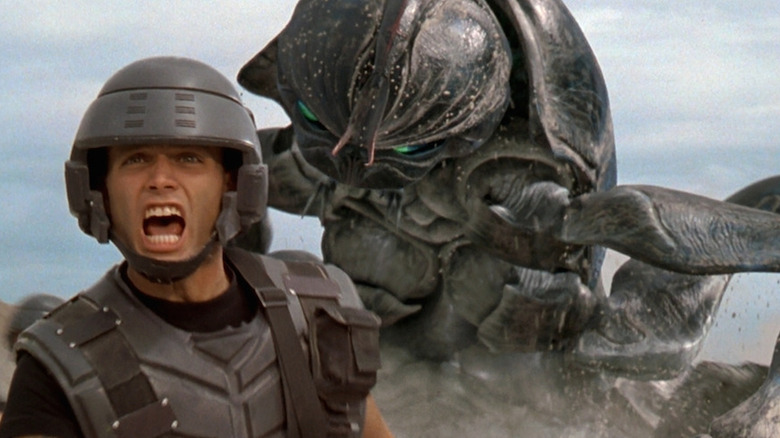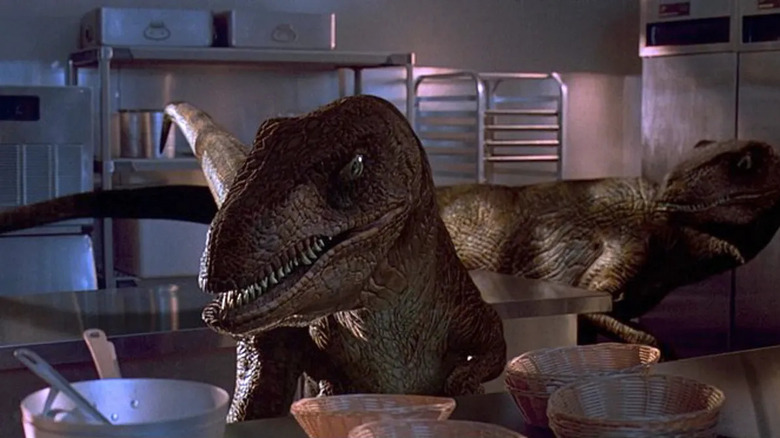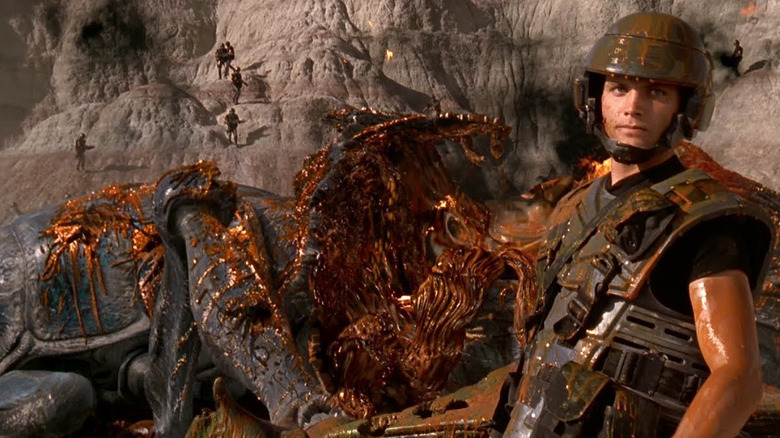Starship Troopers Is Still A Point Of Pride For ILM Effects Legend Phil Tippett
You'll have to get your scrolling finger ready to review the illustrious career of visual effects maestro Phil Tippett. From the gnarly (and LSD-tinged) conjuring of the Rancor in the far, far away galaxy of "Star Wars: Return of the Jedi" (for which he would earn a Best Visual Effects Oscar) to his contributions to the ever-popular fantasy "Willow" under the umbrella of the Industrial Light & Magic (ILM) team, the award-winning designer and stop-motion artist is responsible for some of cinema's most breathtaking sights.
This year sees the 25th anniversary of "Starship Troopers," a satirical joyride erected on malicious compliance with its source material and buttressed with spectacular creatures crafted under Tippett's care. By the time he came onto the project, Tippet was still moving on the momentum of his VFX creature showcase (credited as "Dinosaur Supervisor") alongside effects titan Stan Winston in Steven Spielberg's 1993 adventure excursion "Jurassic Park." There, Tippett offered stop-motion iterations of the dinosaurs (just don't call them monsters) that laid the foundation for the incredible cloned CGI dinos audiences enjoy to this day.
In "Starship Troopers," Paul Verhoeven (no stranger to unflinching provocation) hands over an ironic portrait of a fascist fantasy society at war with giant man-eating arachnid bugs, and Tippett supplies the creepy-crawlies, a point he remains proud of over two decades beyond its release. Looking back on the cult hit, Tippett tells Cinema Blend:
"For me, it was 'Starship Troopers,' because we had just done 'Jurassic Park' before, and ILM and Dennis [Muren] did all the really heavy lifting on that. We did the animation for two scenes, and then Paul [Verhoeven] insisted that I be the visual effects supervisor on 'Troopers.' And I was terrified."
A prior prehistoric project
"Everything I know has some value," Paul Tippett explains to Vice, "Now how do I apply this technology to what I know?"
It was his maxim emerging from "Jurassic Park," but the valuable knowledge brought into it was the animator's nightmarish 1985 film "Prehistoric Beast." The grim-toned dinosaur short would arm him with intimate knowledge of bringing animalistic movements to life; as it turns out, Steven Spielberg would go into "Jurassic Park" aiming for a hyper-realistic beast-dinosaur rather than a guy-in-a-suit monster. Tippett was the right one for the job.
The early 90s was a time when CGI technology was coming out of its shell. One of the decade's biggest blockbusters, "Terminator 2: Judgement Day," peppered a modest amount of computer enhancement in its sci-fi world, but still relied heavily on animatronics, prosthetics, and old movie tricks to deliver thrills. By the time Universal came to adapt Michael Crichton's bestselling novel, filmmakers would still feel a lack of CGI designers to keep up with the emergent moviemaking tech. It was then that Tippett would get his chance to apply everything he knew from his post-"Jedi" side project and help produce full-motion digital creatures as good as any Ray Harryhausen creation (a bar your faves still try to reach).
Side note: fans of Tippett's stop-motion feature "Mad God" can see its bleak seedlings in "Prehistoric Beast," available on Tippett's YouTube channel:
Engineering a Dinosaur Input Device built on the same tech that allowed the AT-ATs to storm Hoth, the team at Tippett studios and ILM fused together stop-motion animation and computer-based modeling, then constructed a launchpad for digitally rendered central characters. For his troubles and triumphs on "Jurassic Park," Tippet took home the Academy Award for Best Visual Effects, along with Dennis Muren, Stan Winston, and Michael Lantieri.
'Would you like to know more?'
Even as the T-Rex roared triumphantly in the wake of the dinosaur picture's success, the animator would carry his maxim with him to future projects. On Rob Cohen's 1996 fantasy epic "Dragonheart," Phil Tippett would meet VFX maestro Craig Hayes, who later designed the deadly warrior bugs in Verhoeven's cult hit.
For the infested landscapes of "Starship Troopers," Tippett was unsure that he would be able to carry the technical feats of "Jurassic Park" over to a story crawling with hundreds of bugs. He adds to Cinema Blend that despite being "terrified" and unconfident going in, his anxieties were quelled in a dream:
It really wasn't until I had a dream that pointed me in the right direction. And it was something that I already knew, but my fear kind of obliterated what I knew. And that was one foot in front of the other. Don't think about anything. Don't think about the step you took before, the step you're gonna take, only be like right there in that moment, dealing with those. Not thousands of problems, but pick the big six problems and focus on those."
Tippett's contributions included building a fully articulated maquette for the warrior bug which, he demonstrates in a show-and-tell with Adam Savage's Tested channel, serves the dual purpose of guiding the computer graphic modelers in the digital animation process and serving as a ready-to-photograph lighting reference. It would come in handy for jaw-dropping battle scenes like this one:
While "Starship Troopers" continues to ride the wave of re-evaluation with the benefit of hindsight, Phil Tippett has plenty to be proud of.


